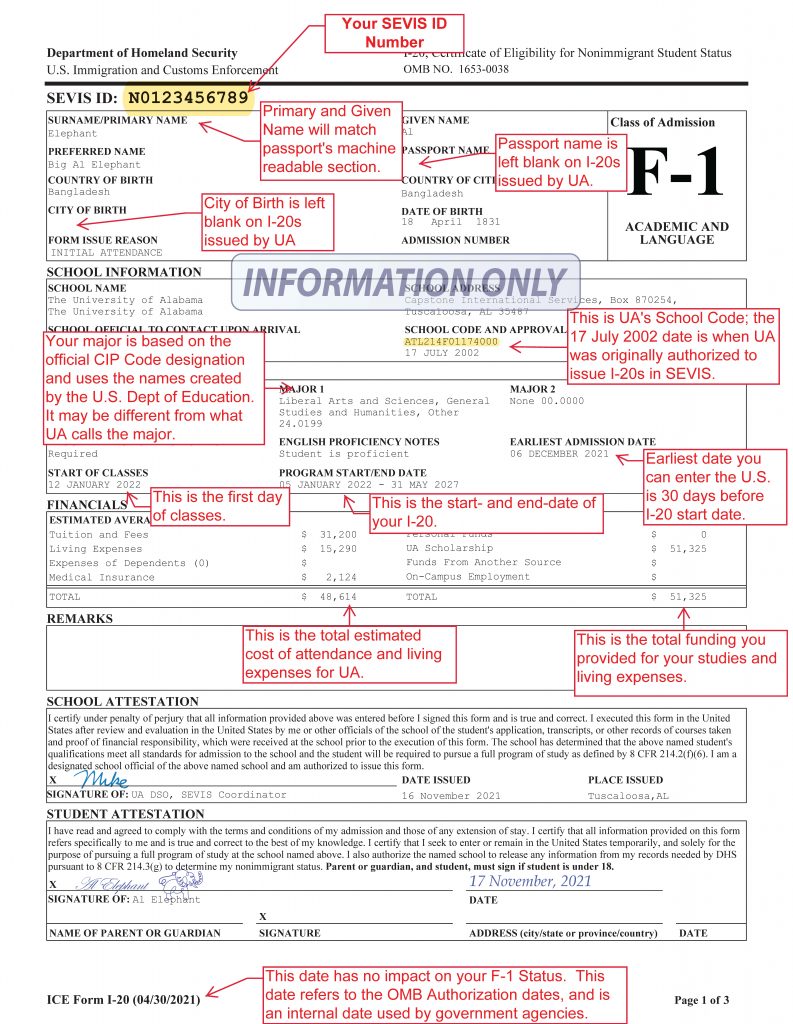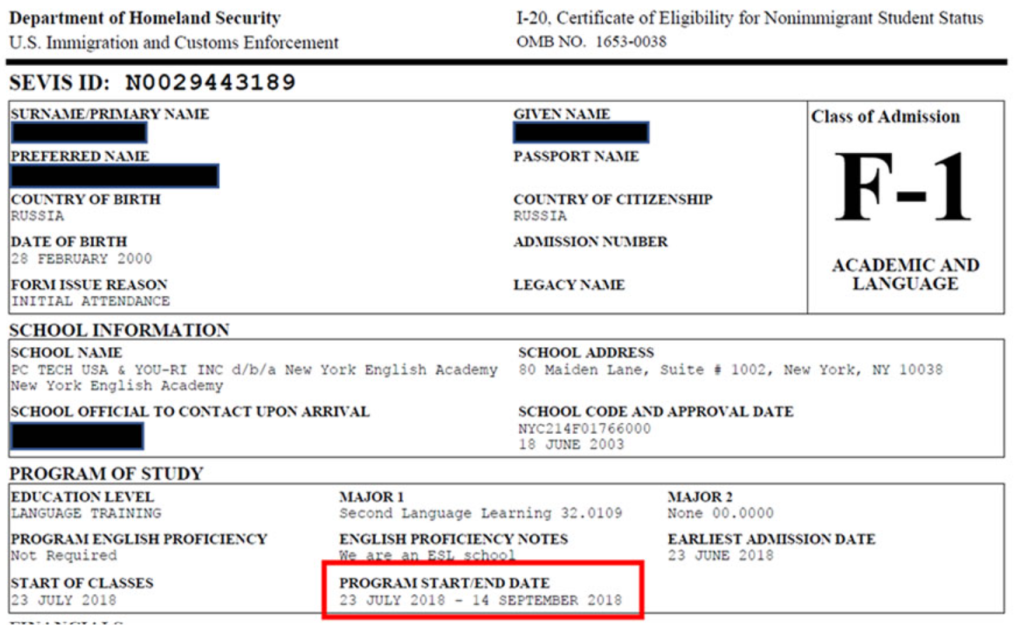
In the context of a US visa, an I-20 form is a Certificate of Eligibility for Nonimmigrant Student Status. It is a document issued by a US government-approved educational institution to international students who have been admitted to a full-time study program. The I-20 form is required for international students to apply for an F-1 or M-1 student visa.
The I-20 form contains important information about the student’s enrollment in the educational institution, such as the program of study, the start and end dates of the program, and the student’s financial resources. The I-20 form also includes a SEVIS ID number, which is a unique identifier assigned to each student in the Student and Exchange Visitor Information System (SEVIS).
International students must present their I-20 form to the consular officer at their visa interview. The consular officer will use the information on the I-20 form to determine whether the student is eligible for a student visa.
Once the student has received their student visa, they must present their I-20 form to the US Customs and Border Protection (CBP) officer at their port of entry. The CBP officer will use the information on the I-20 form to admit the student to the United States as an F-1 or M-1 student.
International students must keep their I-20 form with them at all times. The I-20 form is required to maintain student status in the United States and to re-enter the United States after traveling abroad.
Here are some of the benefits of having an I-20 form:
- It allows you to apply for an F-1 or M-1 student visa.
- It makes you eligible for certain scholarships and financial aid.
- It allows you to work on campus and, in some cases, off campus.
- It allows you to travel outside of the United States and return without having to apply for a new visa.
It’s an essential document for international students who want to study in the United States. Here’s a breakdown of its significance:
- Issuance: U.S. schools authorized by the Student and Exchange Visitor Program (SEVP) issue the Form I-20 to qualifying international students. The designated school official (DSO) at each institution manages this process.
- Purpose: The Form I-20 serves as proof that an international student is eligible to study in the U.S. and indicates that they’ve been accepted into a full-time study program at an SEVP-approved school.
- Visa Application: International students require the I-20 form to apply for an F-1 or M-1 visa at a U.S. embassy or consulate in their home country. The F-1 visa is for academic students, while the M-1 visa is for vocational students.
- U.S. Entry: Upon arrival in the U.S., international students must present their Form I-20 to U.S. Customs and Border Protection officers to gain entry into the country.
- Maintaining Status: While studying in the U.S., international students must ensure that their I-20 remains valid and accurate. This includes updating the form if there are significant changes, such as a switch in major or if additional time is needed to complete their studies.
- Other Benefits: The I-20 form is also required when international students apply for benefits such as Optional Practical Training (OPT), a Social Security Number, or a driver’s license in some states.
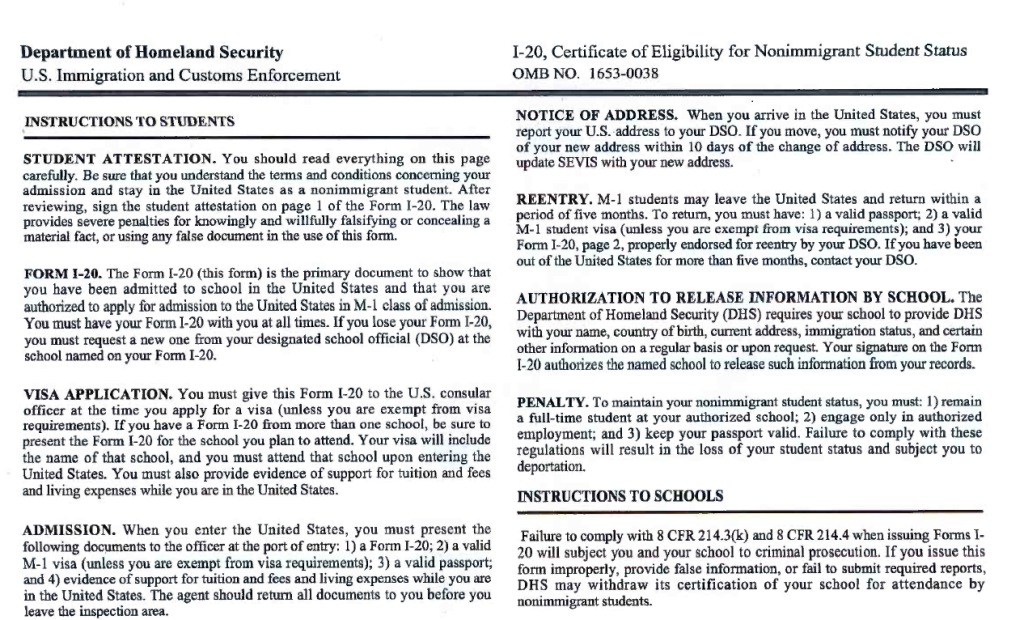
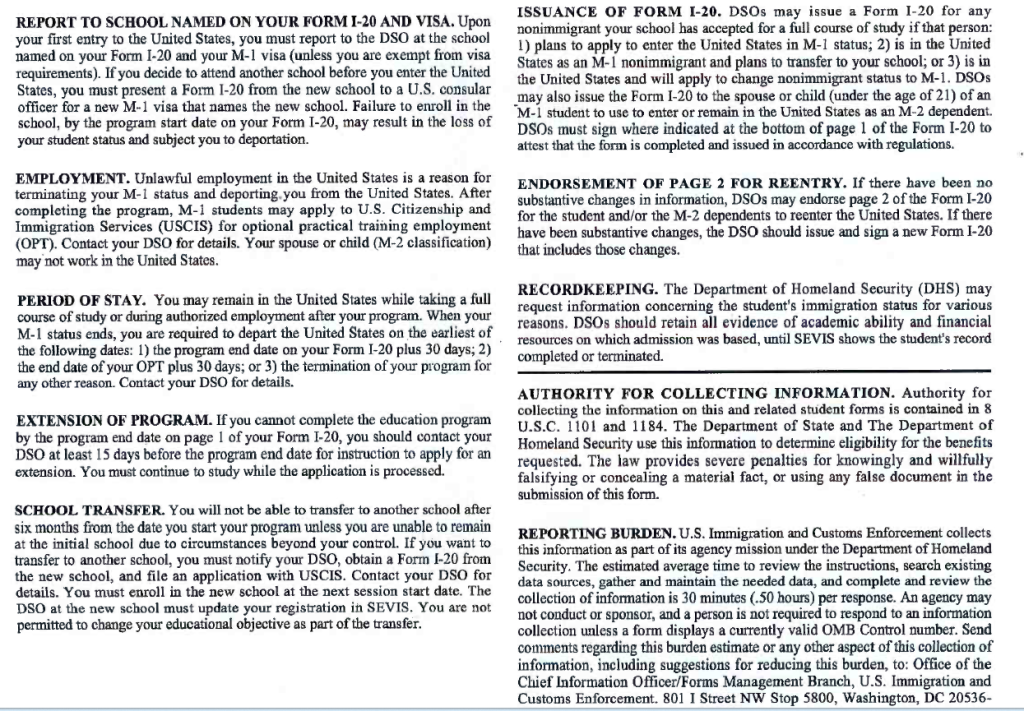
What should i do after getting I-20 certificate?

- Review the I-20 certificate carefully to make sure that all of the information is correct. This includes your name, date of birth, passport number, program of study, and start and end dates.
- Pay the SEVIS I-901 fee. This is a mandatory fee for all international students in the United States. You can pay the fee online at the SEVIS website.
- Schedule an appointment for a student visa interview at a US embassy or consulate. You can schedule an appointment online or by calling the embassy or consulate.
- Gather the required documents for your visa interview. These documents will vary depending on your nationality and country of residence. However, some common documents include your passport, I-20 certificate, SEVIS fee receipt, and proof of financial support.
- Attend your visa interview and answer the questions of the consular officer honestly and accurately.
After receiving your Form I-20 (“Certificate of Eligibility for Nonimmigrant Student Status”), you should follow these steps to continue with the process of studying in the U.S.:
- Pay the SEVIS Fee:
- Before applying for a visa, you must pay the I-901 SEVIS (Student and Exchange Visitor Information System) fee. Make sure you have your SEVIS ID (which starts with an ‘N’ followed by a series of numbers) from your I-20 when you pay the fee.
- Keep the confirmation of this payment, as you’ll need to show it during your visa interview.
- Apply for a Student Visa:
- Depending on your course of study, you’ll either apply for an F-1 (academic or language students) or an M-1 (vocational students) visa.
- Fill out the DS-160 online visa application form.
- Pay the visa application fee.
- Schedule and attend a visa interview at the U.S. embassy or consulate in your home country.
- Prepare for the Visa Interview:
- Gather necessary documents:
- Valid passport
- Passport-sized photo (check specific size and requirements)
- Form DS-160 confirmation page
- Application fee payment receipt
- Form I-20 (signed by both you and a school official)
- I-901 SEVIS fee payment confirmation
- Transcripts, diplomas, or certificates from schools attended
- Evidence of financial ability (proof that you can afford both tuition and living expenses)
- Be ready to explain your study plans, reasons for choosing the particular school, and your post-graduation plans.
- Gather necessary documents:
- Receive a Visa:
- If approved, a visa will be placed in your passport. The visa doesn’t guarantee entry to the U.S. but allows you to travel to a U.S. port of entry and request permission to enter.
- Make Travel Plans:
- You typically cannot arrive more than 30 days before the start date listed on your I-20.
- Remember to pack your I-20 and other important documents in your carry-on bag, not your checked luggage.
- Arrive in the U.S.:
- Present your passport, visa, and I-20 form to the Customs and Border Protection (CBP) officer upon arrival.
- The officer will make the final decision on your admission and may ask you questions about your studies, finances, or plans.
- Report to Your School:
- Check in with your school’s Designated School Official (DSO) as soon as possible. You’ll need to do this before the start date on your I-20.
- Your school may also have an orientation for international students, which you should attend.
- Maintain Your Status:
- Once in the U.S., it’s crucial to maintain your student status. This means:
- Enrolling in a full course of study.
- Not working without authorization.
- Following the rules for any employment opportunities you pursue (like Optional Practical Training).
- Keeping your I-20 valid and updated (e.g., if you change programs or need an extension).
- Once in the U.S., it’s crucial to maintain your student status. This means:
What is SEVIS Fee?
The SEVIS Fee, also known as the I-901 fee, is a mandatory fee for all international students and exchange visitors in the United States. The fee is used to support the Student and Exchange Visitor Information System (SEVIS), a database that tracks the status of international students and exchange visitors while they are in the United States.
The SEVIS fee is $350 for F-1 and M-1 students, and $200 for J-1 exchange visitors. The fee must be paid before the student or exchange visitor can apply for a visa or enter the United States.
The SEVIS fee can be paid online at the SEVIS website. You will need your SEVIS ID number to pay the fee. You can find your SEVIS ID number on your I-20 or DS-2019 form.
Once you have paid the SEVIS fee, you will receive a receipt. You must keep this receipt with you, as you will need to show it to the consular officer at your visa interview.
The SEVIS fee is a one-time fee. You do not need to pay the fee again if you transfer schools or extend your stay in the United States.
Here are some important things to know about the SEVIS fee:
- The SEVIS fee is mandatory for all international students and exchange visitors in the United States.
- The fee is used to support the Student and Exchange Visitor Information System (SEVIS).
- The fee is $350 for F-1 and M-1 students, and $200 for J-1 exchange visitors.
- The fee can be paid online at the SEVIS website.
- You will need your SEVIS ID number to pay the fee.
- Once you have paid the fee, you will receive a receipt. You must keep this receipt with you, as you will need to show it to the consular officer at your visa interview.
- The SEVIS fee is a one-time fee. You do not need to pay the fee again if you transfer schools or extend your stay in the United States.
CHECK I-901 STATUS
URL – https://fmjfee.com/i901fee/index.html?content=status/checkStatus

How to make SEVIS Fees or I-901 fee?
URL – https://fmjfee.com/i901fee/index.html?content=status/checkStatus
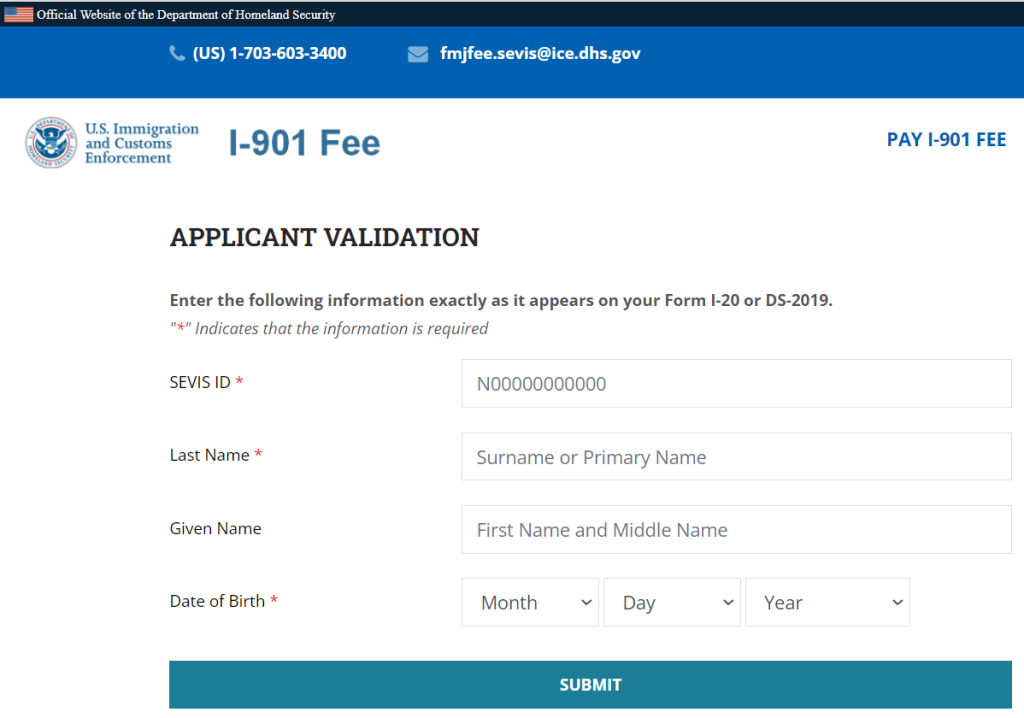
List of frequently asked questions (FAQs) about U.S. immigration as it relates to the Form I-20
- What is the Form I-20?
- The Form I-20, or “Certificate of Eligibility for Nonimmigrant Student Status,” is a document issued by SEVP-certified schools to international students who’ve been accepted into a program of study in the U.S.
- Why do I need an I-20?
- The I-20 is essential for applying for an F-1 or M-1 student visa, entering the U.S., and maintaining student status while in the country.
- How do I get an I-20?
- Once you’re accepted into an SEVP-certified school and provide evidence of financial ability to cover your studies and living expenses, the school’s designated school official (DSO) will issue the I-20 to you.
- Can I have more than one Form I-20?
- You may receive I-20 forms from multiple schools if you’ve been accepted to several. However, you should only use the I-20 from the school you actually plan to attend when applying for your visa and entering the U.S.
- What’s the difference between the I-20 and the F-1 or M-1 visa?
- The I-20 is a certificate of eligibility to study in the U.S., while the F-1 or M-1 visa is the actual permission to enter and remain in the U.S. for study.
- Do I need a new I-20 if I change schools or programs?
- Yes, if you transfer to a different school or change your program of study, you’ll need a new I-20 from the new school or program.
- How long is my I-20 valid?
- Your I-20 is valid as long as you’re continuously enrolled and making regular progress in your program of study. Any significant changes to your program, like extensions or changes in the field of study, may require an updated I-20.
- What should I do if my I-20 is lost or damaged?
- If your I-20 is lost, stolen, or damaged, contact your school’s DSO immediately to get a replacement.
- Can I work in the U.S. with my I-20?
- While the I-20 itself doesn’t grant work permission, F-1 students may be eligible for on-campus employment and certain types of off-campus employment with authorization, like Optional Practical Training (OPT).
- What happens if I violate the terms of my I-20?
- Violating the terms of your I-20 (e.g., not maintaining full-time enrollment or unauthorized employment) can jeopardize your student status and visa. Consequences can range from the need to apply for reinstatement to removal from the U.S.
- Do my dependents need an I-20?
- Yes, if you have dependents (spouse or children) accompanying you to the U.S., each of them will need their own dependent I-20 form (known as F-2 or M-2).
What is the Form I-20?
The Form I-20, also known as the Certificate of Eligibility for Nonimmigrant Student Status, is a document issued by a US government-approved educational institution to international students who have been admitted to a full-time study program. The Form I-20 is required for international students to apply for an F-1 or M-1 student visa.
Who needs an I-20 form?
All international students who are planning to study full-time at a US government-approved educational institution need an I-20 form. This includes students who are planning to study at a university, college, vocational school, or language school.
How do I get an I-20 form?
To get an I-20 form, you must first be admitted to a US government-approved educational institution. Once you have been admitted, the school will issue you an I-20 form.
What information is on the Form I-20?
The Form I-20 contains important information about the student’s enrollment in the educational institution, such as the program of study, the start and end dates of the program, and the student’s financial resources. The Form I-20 also includes a SEVIS ID number, which is a unique identifier assigned to each student in the Student and Exchange Visitor Information System (SEVIS).
What do I need to do with the Form I-20?
You will need to present your Form I-20 form to the consular officer at your visa interview. The consular officer will use the information on the I-20 form to determine whether you are eligible for a student visa.
Once you have received your student visa, you must present your I-20 form to the US Customs and Border Protection (CBP) officer at your port of entry. The CBP officer will use the information on the I-20 form to admit you to the United States as an F-1 or M-1 student.
How long is the Form I-20 valid for?
The Form I-20 is valid for the duration of your program of study, plus an additional 60-day grace period.
What should I do if I lose my I-20 form?
If you lose your I-20 form, you must contact your international student office immediately. They will be able to issue you a new I-20 form.
What should I do if my I-20 form is expired?
If your I-20 form is expired, you must contact your international student office immediately. They will be able to advise you on how to renew your I-20 form.
Can I travel outside of the United States with my I-20 form?
Yes, you can travel outside of the United States with your I-20 form. However, you must make sure that your I-20 form is valid and that you have a valid visa. You must also have a travel signature on your I-20 form from your international student office.
What should I do if I am planning to transfer schools?
If you are planning to transfer schools, you must contact your international student office immediately. They will be able to advise you on how to transfer your I-20 form to your new school.
What should I do if I am planning to drop out of school?
If you are planning to drop out of school, you must contact your international student office immediately. They will be able to advise you on the immigration implications of dropping out of school.

